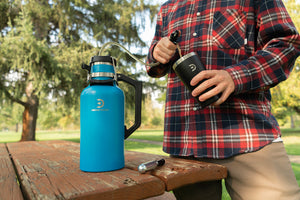A variety of beverages require carbonation. Carbonation is the existence of carbon dioxide gas in the liquid. In simple terms the CO2 gas dissolves in the liquid. This dissolved carbon dioxide is what gives beer its fizz. Now, this dissolving of the CO2 gas into the beer or other beverage can happen one of two ways: either the carbonation occurs naturally through the process of fermentation (brewing the beer) or the CO2 can be forced into the beer under pressure. Another important thing to keep in mind is that any carbonated beverage will go flat if it is exposed to air. To preserve the carbonation in the beer requires that the container the beer is in be sealed tight and that any air in the container be replaced with a gas such as CO2.
The amount of CO2 dissolved into the beer depends on the external pressure and the temperature. For example to carbonate a Porter at 40 degrees F requires that the beer be pressurized at 6 to 7 psi. “Psi” simply means pounds per square inch and just measures how firmly the gas is being compressed. The higher the psi, the more CO2 is being forced into the liquid. But, if you unseal the container, then these bubbles of carbonation begin leaving the beverage.
Another popular drink, kombucha, gets a lot of its “power” from carbonation also. The same two means for carbonation that apply to beer also are typical of kombucha. During the natural fermentation process kombucha creates its own carbonation, And, like beer, it must be contained in a sealed vessel to retain that carbonation. Kombucha can also be force carbonated.
The DrinkTanks Growler when equipped with the patented Keg Cap gives you the means to satisfy the requirements of carbonation. Firstly, the container is air tight. This means that once the air in the container is replaced with CO2, it is unlikely to go flat. And the Keg Cap allows you to put in additional CO2 without opening the container and exposing it to additional air.
Carbonation Chart created by Kegerators.com


